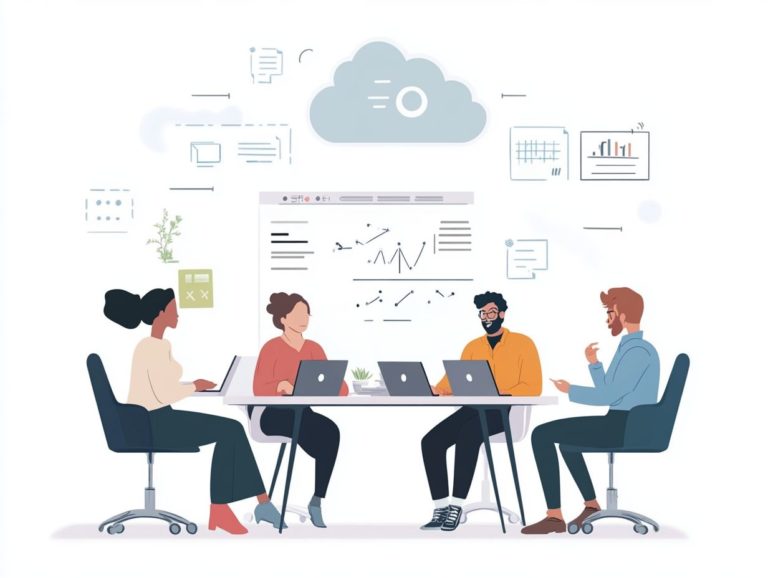Understanding Insider Threats in Cloud Security
In the current digital landscape, insider threats are a big challenge for organizations, especially in cloud security.
This exploration delves into the various types of insider threats, ranging from individuals with malicious intent to those whose actions stem from mere accident.
Common causes often include employee dissatisfaction and inadequate training. These threats can have serious consequences, including data breaches and loss of sensitive information.
We will share best practices and strategies to help you effectively prevent and mitigate these risks, ensuring your cloud environment remains secure.
Contents
- Key Takeaways:
- Types of Insider Threats
- Common Causes of Insider Threats
- Impact of Insider Threats on Cloud Security
- Preventing and Mitigating Insider Threats
- Frequently Asked Questions
- What are insider threats in cloud security?
- How do insider threats differ from external threats?
- What are some common examples of insider threats in cloud security?
- How can organizations prevent and mitigate insider threats in cloud security?
- What role do employee training and awareness play in preventing insider threats in cloud security?
- How Should Organizations Respond to Insider Threats in Cloud Security?
Key Takeaways:
- Insider threats in cloud security can come from both malicious and accidental sources.
- Robust security measures are essential to prevent and detect potential threats.
- Employee dissatisfaction and lack of training are common causes of insider threats.
- Implementing a positive work environment and regular security training is crucial.
- Insider threats can lead to data breaches, emphasizing the need for prevention and mitigation strategies.
- Regular security audits and insider threat detection tools are vital for maintaining security.

Defining Insider Threats and Cloud Security
Insider threats present a considerable challenge for organizations, particularly concerning cloud security, where sensitive data is frequently accessed by numerous employees. Security teams must safeguard these valuable data assets; thus, understanding insider threats is essential for instituting effective security measures.
Insider threats can arise from various sources, including malicious and negligent insiders. Both can potentially cause data breaches and compliance issues. Organizations must prioritize strong access control protocols, continuous monitoring systems, and comprehensive security awareness training to effectively mitigate these risks.
Access control is your first line of defense against insider threats. By implementing strict user permissions and requiring multi-factor authentication an extra layer of security that asks for more than one form of verification you can significantly reduce the likelihood of unauthorized access.
For example, Google Workspace boosts data security by allowing administrators to establish detailed sharing and access permissions tailored to each user s role. Similarly, Tesla uses advanced monitoring systems to track user activities, helping to identify unusual behavior that could indicate potential insider threats.
These strategies highlight the essential role that well-structured access controls and active monitoring play in protecting sensitive information and preserving organizational integrity.
Types of Insider Threats
Insider threats can be categorized into malicious insiders and negligent insiders, each posing unique challenges to your data security.
Malicious insiders intentionally compromise sensitive information, often motivated by personal gain or discontent with their organization. Negligent insiders may unwittingly facilitate data breaches, typically due to a lack of understanding of security protocols.
Both types present significant risks to your organization’s cloud security framework, underscoring the necessity for comprehensive security practices and stringent access privileges.
In conclusion, identifying and addressing insider threats in cloud security is vital for organizations to protect sensitive data and maintain compliance. Take the first step towards securing your cloud environment today!
Malicious Insiders
Malicious insiders represent one of the most significant threats to your organization s systems, often driven by motives like financial gain or revenge. These individuals exploit their privileged access to sensitive information, sneaking around security protocols with ill intent.
To effectively combat this risk, integrating user behavior analytics which involves tracking how users interact with systems to identify suspicious activities and conducting regular risk assessments is crucial for enhancing your overall cloud security.
By continuously monitoring user interactions and analyzing behavioral anomalies, you can build strong protections. For instance, sudden changes in access patterns or unusual data transfers might signal trouble ahead.
Regularly updating your security protocols and providing training to help employees recognize potential insider threats further strengthens your defenses. Cultivating a culture of transparency encourages team members to report suspicious activities without fear, perfectly complementing your technical safeguards.
This proactive strategy helps detect threats early and significantly diminishes the potential impact of malicious actions, ultimately safeguarding your valuable data and maintaining organizational integrity.
Accidental Insiders
Accidental insiders, often referred to as negligent insiders, constitute a notable segment of insider threats, where unintentional actions can lead to data leaks and security vulnerabilities.
These individuals, through careless handling or simply a lack of understanding regarding security protocols, inadvertently compromise sensitive information. This reality highlights the critical need for comprehensive employee training and robust security awareness programs.
By cultivating an environment where every employee feels enabled to prioritize security, you can significantly diminish the chances of incidents stemming from oversight.
Regular workshops, simulated phishing exercises, and transparent communication about security policies can greatly enhance staff understanding. When employees grasp the potential repercussions of their actions, they begin to appreciate their vital role in safeguarding the organization s assets.
This proactive strategy fosters a culture of accountability, ultimately strengthening resilience against both accidental and intentional security threats.
Common Causes of Insider Threats

Understanding the common causes of insider threats is crucial for any organization looking to strengthen its cloud security and safeguard sensitive data.
Key factors contributing to these threats often include employee dissatisfaction, which can spur harmful actions, and inadequate training that leaves personnel unaware of vital security protocols and best practices.
By tackling these issues through enhanced security awareness training and cultivating a positive work environment, organizations can effectively mitigate the risks associated with insider threats while elevating their overall cybersecurity posture.
Employee Disgruntlement
Disgruntled employees pose a serious risk that can lead to insider threats. When employees feel unhappy, they may act out of malicious intent, risking the compromise of sensitive information and organizational systems.
This dissatisfaction can arise from various sources, such as perceived unfair treatment, limited advancement opportunities, or inadequate security measures.
To mitigate the risks posed by disgruntled employees, it s vital to implement robust security policies and nurture a positive work culture.
Recognizing the early warning signs of dissatisfaction is essential. Regularly conducting employee satisfaction surveys, facilitating open forums for feedback, and maintaining transparent communication channels can significantly help identify underlying problems before they escalate.
By proactively addressing concerns and fostering an environment where employees feel valued and heard, you can reduce feelings of resentment. Immediate and ongoing training is essential for all employees to prevent insider threats.
This approach ultimately safeguards sensitive data from potential insider threats.
Insufficient Training and Awareness
Insufficient training and awareness among your employees can increase the risk of insider threats. They may unknowingly do things that put data safety at risk.
A lack of understanding regarding security protocols, access privileges, and compliance issues makes unintentional breaches more likely. This is why you must provide regular employee training and security awareness initiatives.
These measures are key to cultivating a culture of cyber hygiene and risk mitigation. In today s digital landscape, where data breaches can happen quickly, your organization cannot afford to overlook the importance of comprehensive training programs.
It is not just about getting new hires up to speed; ongoing education is vital. Your employees must remain vigilant and informed about evolving threats and best practices.
Engaging your staff through interactive workshops and simulations greatly enhances their ability to identify potential risks and respond effectively.
These initiatives empower your employees and foster a proactive security environment. This significantly reduces the likelihood of costly data incidents and protects your organization’s reputation and customer trust.
Impact of Insider Threats on Cloud Security
Insider threats can significantly influence cloud security, often leading to serious data breaches that jeopardize sensitive information. These breaches can disrupt your organization s smooth functioning.
When breaches occur, they result in considerable financial setbacks, tarnished reputations, and compliance challenges. Conducting thorough risk assessments is essential to pinpoint vulnerabilities and implement strong security measures.
Your organization must stay alert and continuously evaluate insider risk factors to protect your cloud infrastructure effectively.
Data Breaches and Loss of Sensitive Information
Insider threats can cause data breaches and unauthorized access, resulting in the loss of sensitive information. This creates significant risks for your organization and its stakeholders.
These breaches can happen due to both malicious and negligent insiders, leading to data leakage that undermines client trust and violates compliance regulations. You must take proactive measures to enhance data security and protect sensitive information against insider threats.
Consider high-profile cases like Target and Sony, which faced serious challenges due to insiders mishandling access to sensitive data. This led to widespread repercussions and financial losses.
Since insider threats often go unnoticed until it is too late, implementing robust monitoring systems and regular training programs for your employees is vital.
With compliance regulations like GDPR and HIPAA requiring strict adherence to data protection protocols, it is imperative to guard against external threats. You must also cultivate a culture of accountability and security awareness within your organization.
By prioritizing these measures, you can significantly reduce risks and enhance your organization’s overall resilience against potential security breaches.
Preventing and Mitigating Insider Threats

Preventing and mitigating insider threats is essential for your organization to uphold strong cloud security and safeguard sensitive data from potential breaches.
Adopting a blend of proactive security measures, such as continuous monitoring and user behavior analytics (which means monitoring how users interact with the system to spot unusual activities), along with effective incident response plans, can lower your vulnerability to insider threats.
Integrating security awareness training and access management strategies will strengthen your defenses against these risks, ensuring a more resilient security posture.
Start your employee training today!
Best Practices for Cloud Security
Following best practices for cloud security is crucial for organizations to protect sensitive data and effectively mitigate insider threats.
Start by enforcing strict access control policies and conducting regular security audits.
Ensure compliance with industry regulations to guard against unauthorized access.
Build a culture of cyber hygiene today through employee training and security awareness initiatives.
This can significantly strengthen defenses against insider threats.
Regularly update your software and security protocols to tackle emerging vulnerabilities.
This ensures that your defenses remain a step ahead.
Utilizing multi-factor authentication, which means using more than one method to verify a user s identity, and encryption will further enhance your security framework.
These measures make it more difficult for unauthorized individuals to access critical information.
Encouraging open communication about security issues is essential.
When management fosters an environment where employees feel responsible for safeguarding not just their own data but also that of the organization as a whole, it creates a more secure atmosphere.
By integrating these strategies, your business can cultivate a robust environment that prioritizes both security and operational efficiency.
Implementing Insider Threat Detection and Response Strategies
Detecting and responding to insider threats is essential for identifying and mitigating risks effectively.
Leverage user behavior analytics and employ continuous monitoring mechanisms to detect anomalies and potential security gaps.
A well-defined incident response plan will further enhance your ability to respond swiftly to insider threat incidents, minimizing potential damage.
To establish a comprehensive approach, integrate advanced monitoring systems that continuously assess user actions.
This ensures any irregularities are flagged for immediate review.
Formulate detailed incident response plans with defined roles and predefined escalation protocols.
These plans provide a structured reaction to identified threats.
Fostering a culture of security through continuous training and awareness programs enables employees to recognize and report suspicious activities.
This reinforces your organization’s defensive posture against potential insider threats.
Frequently Asked Questions
What are insider threats in cloud security?
Insider threats in cloud security refer to potential security risks posed by individuals with authorized access to a company’s cloud systems and data.
These individuals may intentionally or unintentionally misuse their access to compromise the confidentiality, integrity, and availability of cloud resources.
How do insider threats differ from external threats?

Insider threats originate from within the organization.
This means the individuals responsible for the threats have legitimate access to the cloud resources, making it more challenging to detect and prevent their actions.
What are some common examples of insider threats in cloud security?
Common examples of insider threats include employees sharing sensitive data with unauthorized parties, using weak or compromised credentials, or intentionally stealing or deleting data.
How can organizations prevent and mitigate insider threats in cloud security?
Organizations can prevent and mitigate insider threats by implementing security controls such as access controls, monitoring and auditing tools, and employee training programs.
Regularly reviewing and updating these measures can also help address insider threats.
What role do employee training and awareness play in preventing insider threats in cloud security?
Employee training and awareness are critical in preventing insider threats.
Educating employees on safe security practices reduces the risk of unintentional security breaches or falling victim to social engineering attacks.
How Should Organizations Respond to Insider Threats in Cloud Security?
Organizations must have a clear response plan for insider threats in cloud security.
This plan should outline steps to contain and investigate the threat.
It should also include procedures for notifying affected parties and addressing potential damages.
Conduct a review after an incident to identify security weaknesses and make improvements.
Act now don’t wait until it’s too late!






